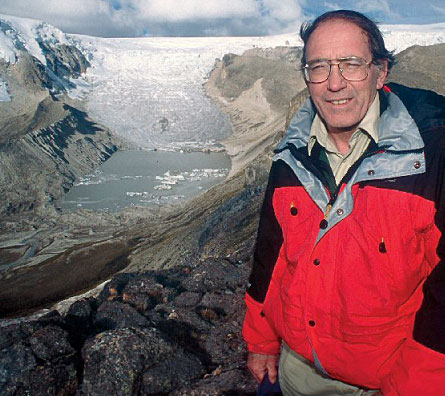Receding glaciers erase records of climate history
- More than 2 years ago
For three decades, Lonnie Thompson of Ohio State University has been monitoring the health of glaciers atop mountains from Peru to China . Skeptics initially doubted that he could retrieve meaningful data from these remote elevations. But he has, while also discovering that these millennia-old data-storage lockers are rapidly disappearing. Senior Editor Janet Raloff recently spoke with Thompson about what science is losing.

When did you first learn high-elevation glaciers were dying?
When we started our monitoring program in 1978, people typically described the movement of ice fields as slow — you know, glacial. But in the early ’90s during repeated visits to Peru ’s Quelccaya glacier, the largest tropical ice cap on Earth, we realized it was in rapid retreat. Although 168 meters thick at the top, it’s now retreating up the mountainside by about 18 inches a day, which means you can almost sit there and watch it lose ground.
Mount Kilimanjaro in Tanzania has lost 84 percent of its ice since 1912. As of our 2007 measurements, it was down to 2 square kilometers. And even that measurement is deceptive because it’s not only losing area but depth. In some places, it may only be a half-meter thick.
How unusual is the warming that these glaciers are experiencing?
Whether you’re looking at glaciers in the Andes of South America or in the Himalayas, you see a similar trend. The whole atmosphere is warming in the tropics. But the greatest warming is taking place at the highest elevations — on the order of 0.3 degrees C per decade.
From a science perspective, what’s so special about these glaciers?
Weather stations are located where people live — in mountain valleys and other lower-elevation regions. They’re not on glaciers where long-lived ice is around to capture and store pollen, pollutants and isotopic anomalies reflecting seasonal temperature variations.
Ice masses on the tops of mountains — sticking out in the free atmosphere — have been collecting climate data and storing them, in many cases for very long periods. One ice core from Mount Kilimanjaro contains climate data going back 11,700 years, far longer than any documented history.
Data from tropical glaciers offer information about how vegetation has changed in the past; the history of El Ni±os — their intensity, magnitude and periodicity; how monsoons have varied through time; even dust data reflecting the duration of major droughts.
Although glaciers in some polar regions may be healthy, the climate that’s important to people is the climate where they live. And these tropical glaciers represent a history of climate in areas of human civilization.
How robust are those climate data?
Glaciers record the deposition of snow in annual layers. They’re like tree rings. One can calibrate the age of glaciers by identifying layers of ice that record a common event for which the date is known, like fallout from thermo-nuclear bomb testing. For a long time, the signature of bomb tests was evident in all ice cores. But in 2006 we were taken aback by analysis of ice cores that we drilled on the Tibetan Plateau…. There was no isotope signature recording bomb tests during the early 1950s and ’60s.
Those data had been really useful because they validated a timeline. They allow you to calibrate ice-accumulation rates, when dust and certain chemical changes occurred, or oxygen-isotope data suggesting temperature variations. The loss of the bomb signature also signaled another important change: the loss of mass not only at the margins of a glacier, but also in depth — from the surface down.
So relatively recent climate history is disappearing. But that history starts to degrade long before the ice is gone. We’ve seen that as soon as melting occurs on an ice field — which at Quelccaya was 1991 — water begins to move vertically through the porous surface, taking with it climate residues. This meltwater eliminates annual signals. And this compromises its historical value.
Who will suffer from its loss?
Certainly climate scientists. But plenty of others as well. More than 600,000 people died in 1792 because of droughts associated with a major monsoon failure in India . What appears to be a 300-year drought beginning 4,186 years ago brought an end to Egypt’s first kingdom — when the pyramids were built — and led to mass starvation and migrations. Signatures of the dust from those events appear in the ice record.
These data offer perspective on how serious and long-lasting the impacts of natural climate have been. I think we can learn powerful lessons from that relationship between climate and the rise or fall of civilizations — lessons that might help us in the 21st century.